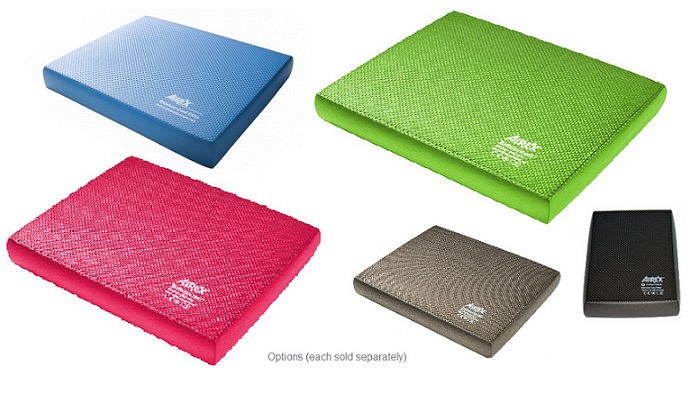 |
AIREX® Balance Pads - Regular or Elite - The special waffle texture on the upper and lower sides of the AIREX Balance Pad Elite is slip-resistant on the one hand and simultaneously provides pleasant stimulation of the foot receptors during barefoot balance training on the other hand. Thanks to destabilization with the Balance Pad Elite, the body is constantly challenged in order to maintain balance and stabilize the joints. Training with the Balance Pad Elite can purposefully improve conditional and coordinative abilities in combination, for example, strength, endurance, differentiation, and balance. Balance Pad is not entirely slip-resistant on smooth floors. We therefore recommend an AIREX mat underneath as the ideal complement. Simple to clean, antimicrobial finish.
Features:
- Active therapy and training devices made of the familiar soft AIREX foam material.
- The Balance Pad Elite is the further development of the proven Balance Pad.
- A special waffle textures on the upper and lower sides is slip-resistant on the one hand and simultaneously provides pleasant stimulation of the foot receptors during barefoot balance training on the other hand.
- The thickness of 6 cm gives the Balance Pad Elite the desired destabilizing characteristics.
- Due to yielding foam, the body is constantly challenged in order to maintain balance and stabilize the joints.
- Exercises more, deeper muscles compared to performing the same exercises without the Balance Pad Elite.
- Control brain functions are activated and receptors in joint and fascia system are stimulated more strongly.
- Training with the Balance Pad Elite can purposefully improve conditional and coordinative abilities in combination, for example strength, endurance, differentiation and balance.
- It is used in rehabilitation and prevention as well as recreational and professional sports.
- As the ideal complement, we recommend an AIREX mat underneath, especially for exercises that are performed e.g. while lying down or in the side push-up position.
- The extremely soft closed-cell foam material does not absorb moisture or dirt and is highly durable.
- Its antimicrobial hygiene protection keeps even the aggressive MRSA bacteria in check.
Quantity: 1
Material: Closed-cell foam.
Manufacturer: AIREX®
Indications: Simultaneously provides slip-resistance and pleasant stimulation of the foot receptors during barefoot balance training. Ideal for one-legged and single-handed functional dynamic training & exercise.
Suitable for:
- Fitness/Prevention
- Pilates/Yoga
- Physiotherapy/Rehabilitation
- Club Sport/School Sport
- Sport Therapy
- Balance Therapy/Training
Indications: Simultaneously provides slip-resistance and pleasant stimulation of the foot receptors during barefoot balance training. Ideal for one-legged and single-handed functional dynamic training & exercise
Options:
Regular
Blue (23401) Dimensions: 19.7" x 16.1" x 2.4" UPC: 603865235015
Elite
Lava (23430) Dimensions: 20 x 16.4 x 2.5"
Blue (23531) Dimensions: 20 x 16.4 x 2.5"
Kiwi (30-1915-KIW) Dimensions: 20 x 16.4 x 2.5"
Pink (30-1915PNK) Dimensions: 20 x 16.4 x 2.5"
Elite - Mini
Mini - Lava (30-1909) Dimensions: 16 x 9.8 x 2.5"
   
What Makes Airex Balance Pads Unique
- Options:
Standard
Standard - Lava (23430) Dimensions: 20 x 16.4 x 2.5 inches
Standard - Blue (23531) Dimensions: 20 x 16.4 x 2.5 inches
Standard - Kiwi (30-1915-KIW) Dimensions: 20 x 16.4 x 2.5 inches
Standard - Pink (30-1915PNK) Dimensions: 20 x 16.4 x 2.5 inches
Mini
Mini - Lava (30-1909) Dimensions: 16 x 9.8 x 2.5 inches

|
|
 |



 Love IT
Love IT 


